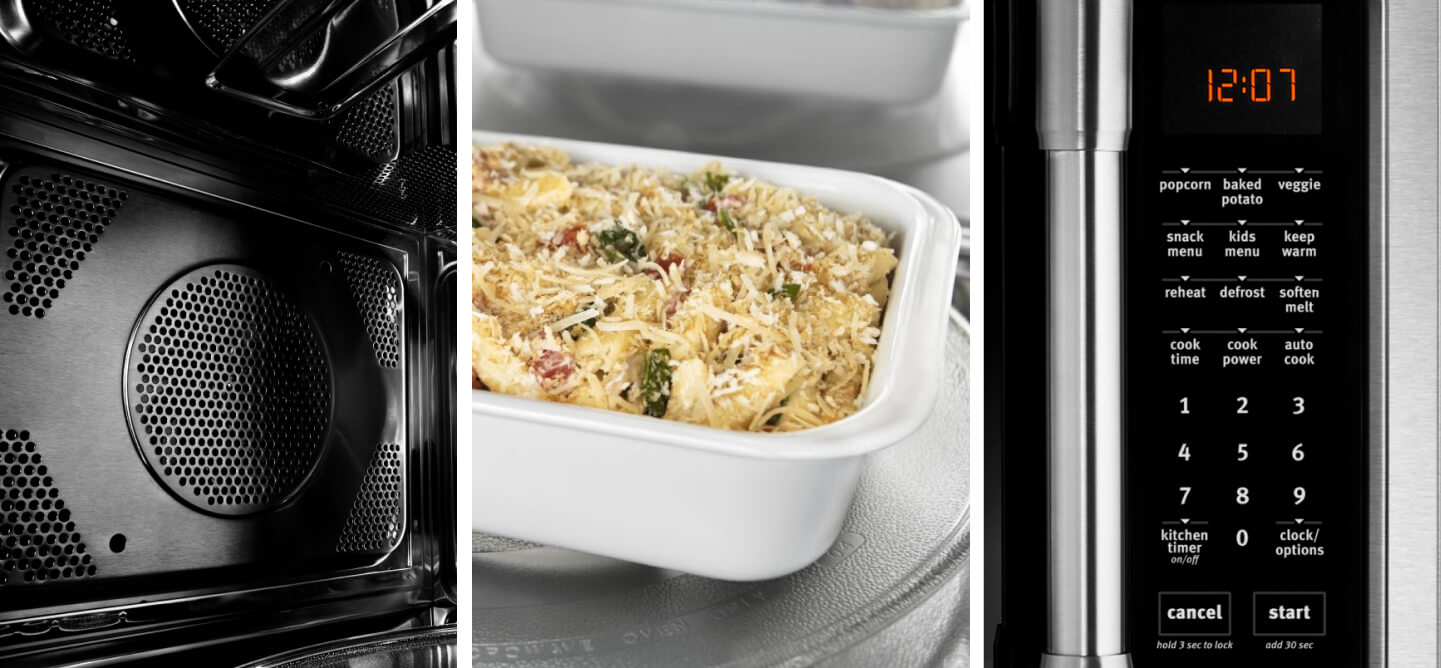
HOW DOES A MICROWAVE WORK?
Microwaves are built to deliver hot food fast with a variety of functions to help defrost, reheat and more. Some microwaves also offer settings similar to conventional ovens, like cycles that use broiler-like heat, convection cooking or low heat to keep food warm. If you’ve ever wondered how a microwave operates, read on to learn more about the inner workings of this convenient kitchen appliance.
HOW DOES A MICROWAVE HEAT FOOD?
Microwaves cause the molecules in food to vibrate, creating heat. This happens when a magnetron creates electromagnetic waves inside the microwave that pulse back and forth through the microwave’s interior, bouncing off the interior’s metal walls. They finally penetrate and heat the food inside.
If your microwave isn’t heating food properly, find out what may be causing the issue and how you can potentially help repair your microwave.
Conventional ovens, on the other hand, cook from the outside in, migrating heat by conduction from the outside of the food toward the middle. Learn more about the differences between a microwave and an oven.
THE BENEFITS OF MICROWAVE COOKING
There are numerous benefits to cooking with a microwave. These include, but are not limited to:
Time Saving: Microwaves can help prepare a meal in minutes as opposed to other cooking methods.
Convenient: Minimal to no food preparation is typically needed when using a microwave. Plus, microwaves come with different settings and often only require the press of a button to achieve the results you want.
Multifunctional: Microwaves can be used in a variety of ways, with settings on some models including reheat, toast, broil, bake and more.
- Energy Efficient: Microwaves can be more energy efficient than conventional ovens, and may help you save on energy costs.
ARE MICROWAVES SAFE?
Using your microwave per the manufacturer's guidelines, which includes only reheating food and utilizing appropriate dishware, makes it a practical and convenient choice for cooking and reheating meals. You should always take caution when removing food from the microwave, as food items may be hot.
Take caution with food safety when using a microwave. Microwaves may have trouble penetrating thicker pieces of food, resulting in uneven cooking. Allow your food to rest for several minutes after using the microwave to ensure heat is distributed evenly.


MICROWAVE SETTINGS THAT BRING THE HEAT
On top of traditional microwave heat, some microwaves offer cycles and settings that go beyond the norm. Learn more about how a microwave oven works through the explanation of a few settings below.
SENSOR COOKING
Microwaves with sensor cooking adapt to your dinner with ideal time and power settings. The sensor detects moisture released from food as it heats and adjusts the cooking time accordingly.
CONVECTION COOKING
Convection cooking is similar to baking in a regular oven with a convection setting. Convection microwaves allow you to bake, roast and heat foods as the heating element heats the air, and a fan circulates it around food. A microwave with a higher wattage can help cook food faster and may offer more settings and features. Read more about microwave wattages to help find the right fit for your kitchen.
Some microwaves have a “combination” setting that alternates between convection and traditional microwave cooking, combining the benefits of outside-in and inside-out cooking.
TOP-DOWN HEAT
Some microwaves offer a kind of broiler-like, top-down heat for browning and crisping, bringing the advantages of a traditional oven to the microwave.
LOW HEAT FOR KEEPING FOOD WARM
Keep Warm settings use a heating element or the magnetron to keep finished meals warm and ready to eat. Some microwaves keep food warm for up to 60 minutes, so the whole meal hits the table at once.
SHOP MAYTAG® MICROWAVES BUILT TO DO MORE
Many newer microwaves are expanding on how a microwave traditionally works with Maytag brand offering features on select models like convection cooking or the Keep Warm function. You can even bake, broil and toast all in one appliance with this Maytag® Flush Mount Over-the-Range Toaster Oven Combination. Some Maytag® microwaves use Sensor Cooking to detect moisture released from food as it heats, then adjust the cooking time accordingly.


